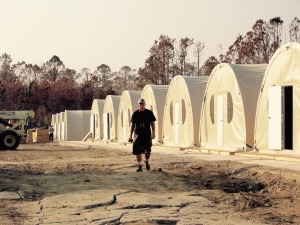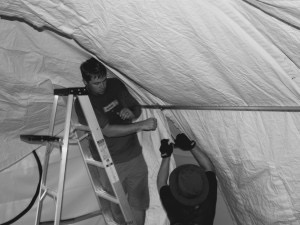Ten Years After Katrina – A Personal Account by Matt Triplett
Ten years ago this week, as part of a volunteer team with the Hotes Foundation, I flew from Seattle, Washington, to Pensacola, Florida, then drove 150 miles to the twin cities of Waveland and Bay St. Louis, Mississippi, considered by many to be “Ground Zero” for Hurricane Katrina. Days earlier, the eye of the storm passed over the pair of small coastal cities, all but erasing them from the map. Coming into the area that first afternoon, it was hard to take in the totality of destruction, a mile-wide swath of coastland striped clean, nothing left but the foundations of homes, and an eerie, tomb-like silence.
For the next 35 days, I worked amidst the wreckage as temperatures soared into the 90’s and the humidity did the same. The mayor of Waveland, Tony Longo, was there, as were a few residence camped on Coleman Avenue that pointed to the top of a large tree they had somehow clung to and managed to survive while riding out the storm surge that destroyed their town.
Even they couldn’t explain exactly how or why they were spared. Beyond these few people, and local first responders, the Hotes team was the only sign of volunteers or aid workers on the scene.
Five days earlier, at 6:10 am local time, Hurricane Katrina made landfall as a strong Category 3 hurricane with sustained winds of 125 mph and a 30-foot storm surge. Century-old trees were snapped like matchsticks, whole city blocks washed away, cars and boats tossed about like toys.
New Orleans, 55 miles to the west was inundated with floodwaters when levees broke and the Super Dome became an impromptu refugee camp. A scene of true tragedy, the city received the vast majority of media attention, but I couldn’t help notice how even weeks after the initial disaster, smaller, lesser known places like Waveland and Bay St. Louis continued to go largely ignored.
The Logistics of Operating in a Disaster Zone Sink In

St Clares Catholic Church, School Units
The logistics of operating in a disaster zone after a hurricane such as Katrina are considerable. I was new to the Hotes Foundation and this would be the first of many volunteer missions I’d go on in the ensuing years.
During the first week of our stay, we had to commute three hours each way to and from Gulf Shores, Alabama, the closest place we could find lodging. Rising at 4:00 am, we’d drive to Waveland, work until dark, and then drive the return leg home, sleep for a few hours, then repeat.
Each day on Interstate 10 we passed scenes of incredible destruction: telephone poles snapped in half; metal billboard signs folded over like paper; whole houses, practically intact, floated off their foundations and deposited miles away. The closer and closer we got to Waveland and Bay St. Louis, the more and more it looked like a war zone. I remember the only thing left standing on the entire length of Coleman Avenue in Waveland was a concrete bank vault.
As days became weeks and the initial shock wore off, I noticed a deeper, more emotional reckoning taking place, and how each member of the team dealt with the trauma in their own fashion. Police with cadaver dogs were often seen searching the wreckages of homes for bodies and nightly we’d hear on the radio that the death toll across the region was rising. I’d call home nightly and keep the conversation light. I would tell myself, “Just work, keep your head down and work. That is the only thing you can do, just work hard.” The scale of the devastation was so large it seemed I could only take it in in bits and pieces.
And indeed, the work kept me busy. The Hotes Foundation donated a number of Alaska Structures buildings, each with air conditioners, lighting, electrical outlets, and carpeted and wood floors. The Hotes team built the City of Waveland administrative buildings, command centers, fire stations, and police headquarters.
In addition, our buildings became the St. Clare’s Catholic Church as well as their school, and we provided support buildings to schools in Bay St. Louis, as well as buildings for temporary housing in Buccaneer Park, among other buildings throughout the area affected by the eye of the storm.
Sights, Sounds, and Smells of Waveland and Bay St. Louis
The sights, sounds, and smells of Waveland and Bay St. Louis will never leave me. I can honestly say, up until that point, I’d never experienced anything even remotely like it. More to the point, the work I did there was important. I could have stayed home and donated online and pretended that was enough, but I had an opportunity to go to Mississippi and be on the ground and make a real difference.
Because I learned giving is more about going directly to where help is needed and giving your time for others. To give without sacrifice is to not give at all. I’m proud of what the Hotes Foundation was able to accomplish. Personally this experience was about understanding myself, why I was volunteering and was the genesis of my involvement in just about every major disaster over the last 10 years. My role in future disasters was only beginning.
Today, over 12,000 residents have returned to Waveland and Bay St. Louis, and they are the true heroes of this story. On this, the tenth anniversary of a storm that impacted an entire country, I want to wish them and their families the best.



